
Melia - Neem Tree: planting and growing
Contents
The Neem Tree in a nutshell
- Melia azedarach, commonly known as the Persian Lilac or Chinaberry, is native to Asia and northern Australia. It thrives in temperate to tropical regions.
- These are deciduous trees, characterised by their pinnate or bipinnate leaves, offering a beautiful, delicate texture.
- The Persian Lilac produces clusters of small, fragrant flowers, typically lilac or purple in colour, which appear in spring.
- After flowering, the tree bears spherical fruits, resembling small yellow or green drupes, containing seeds that can be used in various traditional applications.
- Melia azedarach is valued for its ornamental qualities, as well as for its medicinal and insecticidal properties.
The word from our expert
The Melia azedarach, commonly known as the Persian Lilac or Chinaberry, is sure to pique the curiosity of any self-respecting gardener. As you might have guessed, the Persian Lilac is not just an ornamental tree—it’s a true botanical treasure with a touch of eccentricity.
Native to Asia and Northern Australia, the Melia azedarach has journeyed across continents to find its way into our gardens. Why such success? Perhaps thanks to its delicately pinnate leaves, which dance in the wind, offering a captivating natural spectacle. But wait, there’s more!
In spring, the Persian Lilac transforms into a fragrant stage. Its flowers, tiny lilac or purple stars, emerge in clusters to provide an olfactory feast. A true floral show! But don’t let yourself get too carried away, because after flowering come the fruits. These small yellow or green spheres may seem innocent, but they hold secrets. Indeed, they have been used for centuries for their medicinal and insecticidal properties.
The Persian Lilac isn’t very demanding, but it appreciates attention. Well-drained soil, a sunny spot, and it will reward you with rapid and vigorous growth. Be warned, though—it can become a bit invasive if left unchecked. Quite the character, this Persian Lilac!
Beyond its beauty and virtues, the study of Melia azedarach is full of anecdotes. Did you know that in Turkey, it’s called the “rosary tree” because its seeds were used to make rosaries? Or that in some cultures, it’s considered a protective tree, warding off evil spirits?
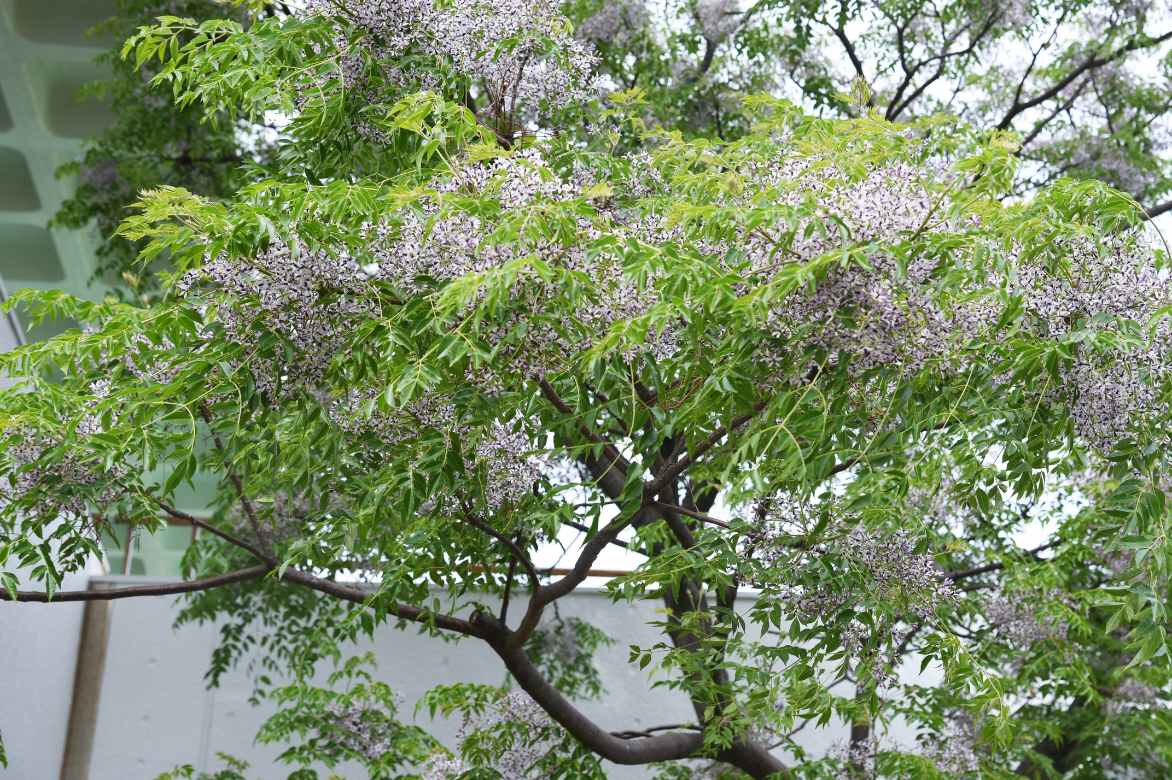
The spring flowering of Melia azedarach
Botany and description
Botanical data
- Latin name Melia sp.
- Family Meliaceae
- Common name Margosa tree, Bead tree, Neem, Persian lilac
- Flowering May to July
- Height 10 m
- Exposure sun or partial shade
- Soil type moist to dry, but well-drained
- Hardiness -9°C
The botanical genus Melia, best known for its most famous species, Melia azedarach (Margosa tree or Persian lilac), belongs to the Meliaceae family. The Melia genus comprises five species: Melia dubia (syn. Melia composita), Melia floribunda, Melia candoleii, Melia parasitica, and Melia azedarach.
The species of the Melia genus are primarily native to tropical and subtropical regions of Asia and Australia. They are adapted to varied climates, ranging from warm temperate zones to tropical regions. Melia species are naturally found in diverse habitats. They generally prefer well-drained soils and can be found in forests, wooded areas, and sometimes in urban settings where they are planted as ornamental trees. Their adaptability allows them to thrive in a variety of environmental conditions.
The Margosa tree, or Melia azedarach, is a tree that captivates attention at first glance. Standing with natural elegance, it boasts a rounded, sometimes asymmetrical silhouette that can reach up to 15 metres in height. Its presence in a garden or urban landscape is all the more remarkable due to its majestic habit and well-defined tiers.
The bark of the Margosa tree, greyish-brown in colour, tells the story of its growth over the years, cracking slightly with age. The foliage is deciduous and is a spectacle in itself. Its pinnate leaves, delicate and light, create a play of shadows and light, particularly soothing on sunny days. The leaf colour is green in season, turning yellow in autumn.
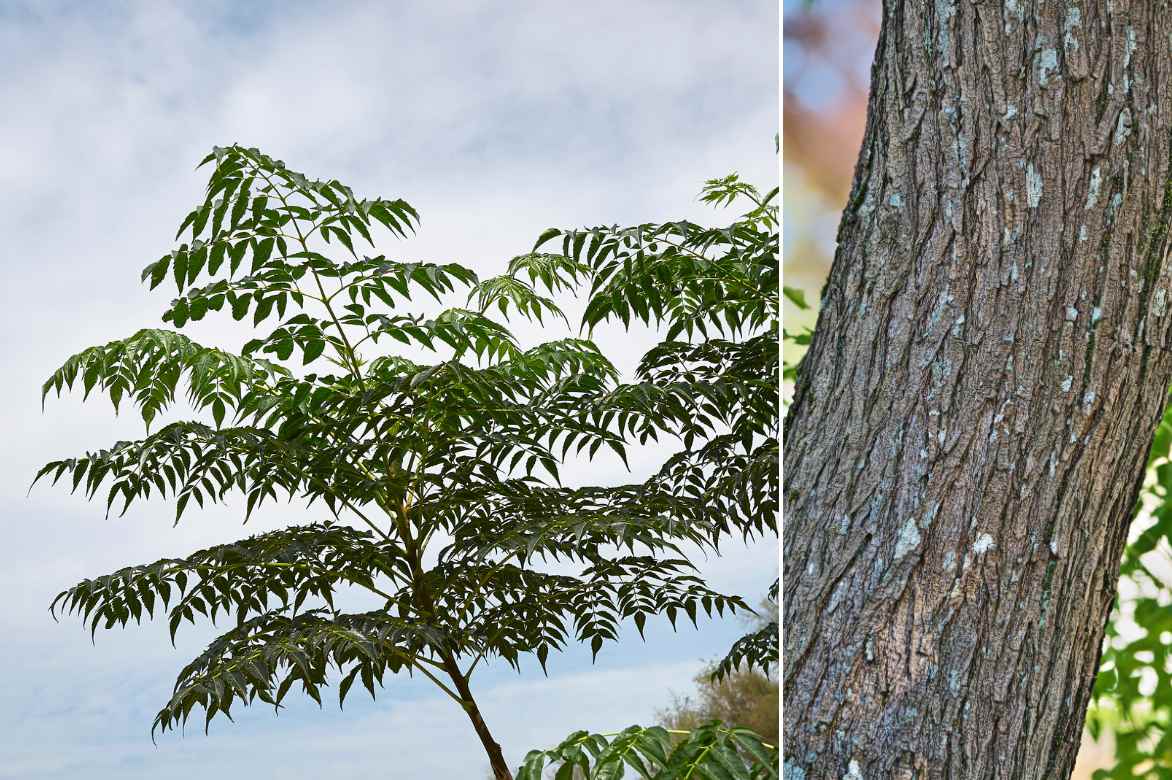
In spring, the Margosa tree adorns itself with clusters of small lilac or purple flowers, emitting a subtle and pleasant fragrance. Each flower is small, with five petals. The floral clusters can be quite voluminous, giving the tree a very floriferous and spectacular appearance in spring. These flowers are not only a feast for the eyes but also a gathering point for bees and butterflies.
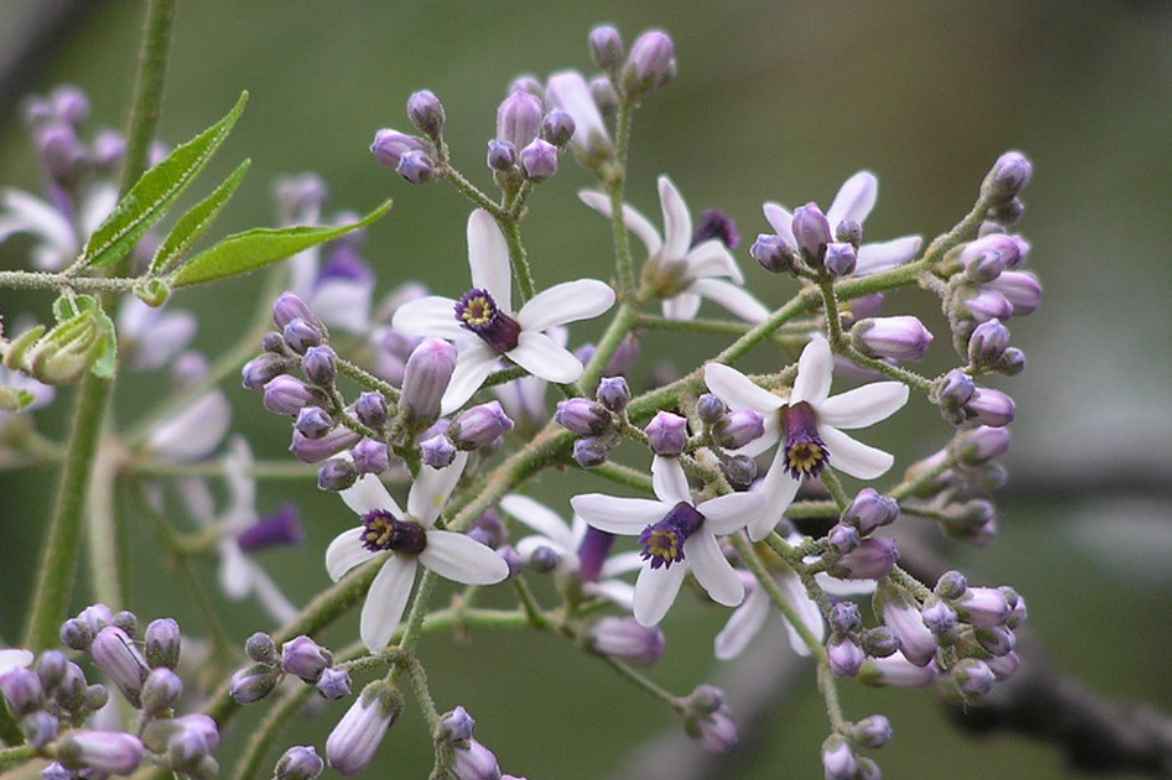
An exquisite flowering (© HQ)
Fruiting follows flowering, giving rise to spherical drupes, initially green and turning yellow as they ripen. These fruits, though decorative, should be handled with care as they are toxic to humans. The Margosa tree reaches sexual maturity quite quickly, often just a few years after planting.
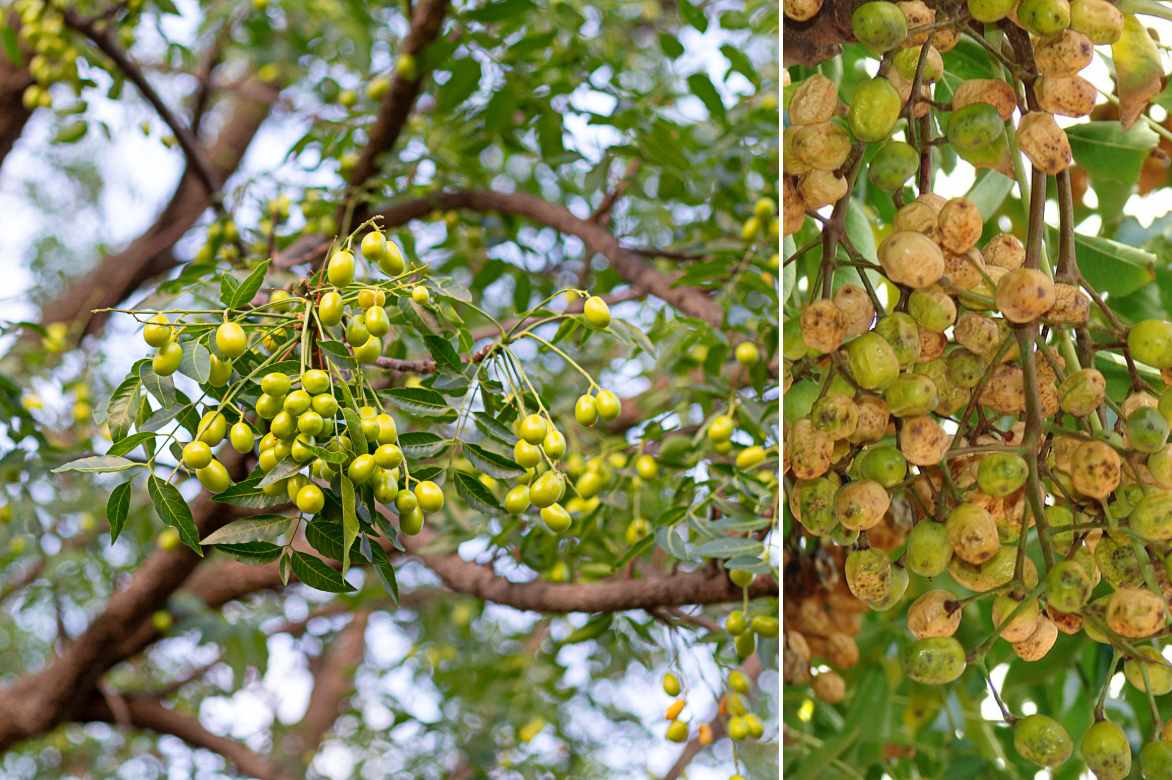
The fruits of the Margosa tree. Right photo ©Wikimedia Commons
Inside each fruit, seeds await their turn to perpetuate the life cycle of this remarkable tree. These seeds are typically brown, hard, and smooth, with a modest size, suited for dispersal by birds and other animals that consume the fruits.
The Margosa tree is not just an ornamental tree; it is also used in various traditional practices, notably for its medicinal and insecticidal properties.
A few varieties

Melia azedarach
- Flowering time June to August
- Height at maturity 9 m
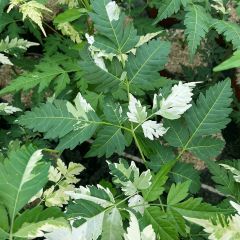
Melia azedarach Jade Snowflake
- Flowering time June to August
- Height at maturity 9 m
Planting the Neem Tree
Where to Plant?
The Neem tree prefers sunny locations. A spot that receives full sun for most of the day is ideal for its growth and flowering. However, it can thrive in partial shade, or even in shade for variegated varieties, though it will be less floriferous in such conditions.
It adapts to a variety of soil types but prefers well-drained soils. Avoid areas where water tends to stagnate.
Choose a location sheltered from strong winds, as its wood is quite brittle.
Although hardy and adaptable, the Neem tree thrives best in temperate to tropical climates. It can withstand short periods of frost, but extremely low temperatures can damage the tree. It is only hardy down to -9°C and in well-drained soil.
Given its potential size and spreading habit, it is important to plant the Neem tree in a sufficiently large space to accommodate its growth. Additionally, as the fruits of the Neem tree are toxic to humans and some pets, it is advisable to plant this tree at a distance from children’s play areas or areas frequented by pets.
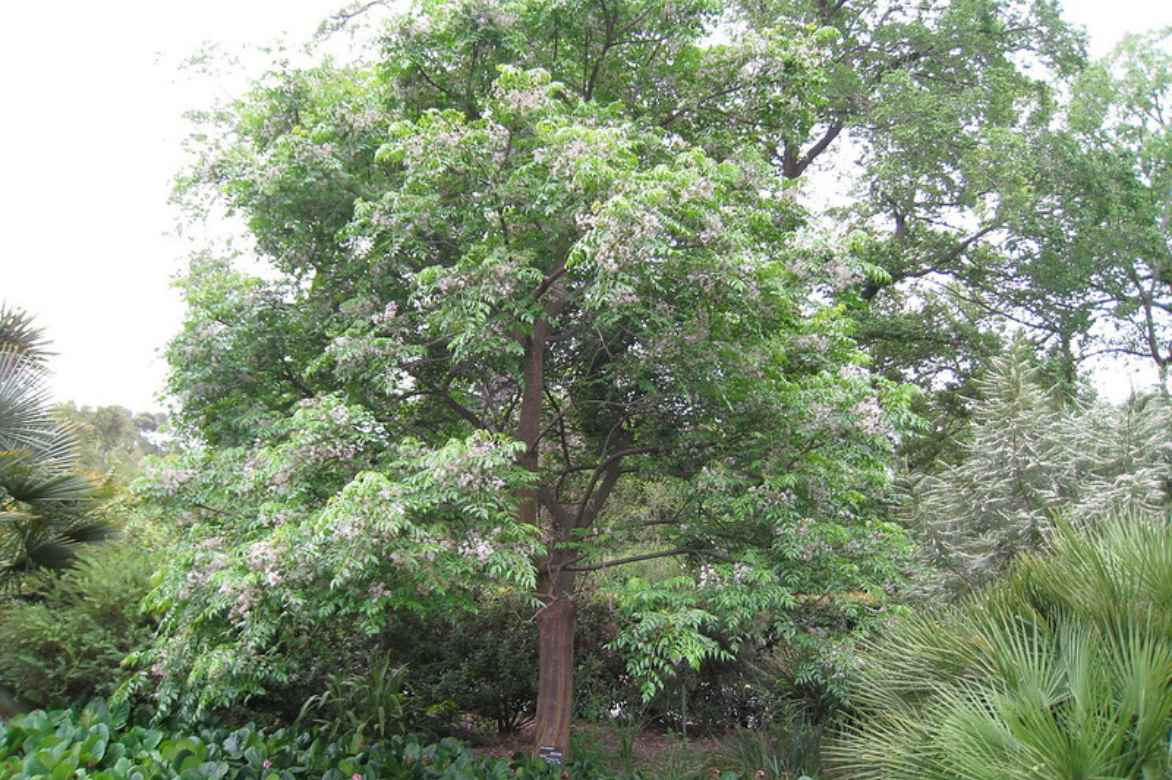
Melia Azedarach ( ©Wendy Cutler)
When to Plant?
In temperate regions, planting is best done in early spring (April), once all risk of frost has passed. This allows the tree to establish itself during the growing season before facing its first winter. In milder climates, it is better planted in October.
How to Plant?
- Dig the hole: Dig a hole twice as wide as the root ball and slightly deeper. This allows the roots to spread easily into the surrounding soil.
- Place the tree: Remove the tree from its container and gently loosen the roots if they are coiled. Place the tree in the hole so that the base of the trunk, the collar, is level with the surrounding soil.
- Fill the hole: Fill the hole with the original soil, lightly tamping to eliminate air pockets. Be careful not to bury the collar.
- Watering: Water the tree thoroughly after planting to establish good contact between the roots and the soil. This will also help reduce transplant shock.
- Mulching: Apply a layer of mulch around the base of the tree to retain moisture, suppress weeds, and protect the roots.
- Post-planting care: Water the tree regularly during the first growing seasons, especially during dry spells. A regular supply of water is crucial for the development of a healthy root system.
Maintenance of Melia
The Melia azedarach or chinaberry tree is a relatively easy-to-maintain tree.
When it comes to watering, it requires special attention when young to ensure it establishes well. Once established, the chinaberry tree tolerates drought well, but regular watering during periods of intense heat or prolonged drought helps maintain its vigour.
Regarding pruning, the chinaberry tree can be pruned to control its shape and size or to remove damaged or misplaced branches. Pruning is best done in late winter or early spring, before the onset of new growth. However, excessive pruning is unnecessary, as the tree has a naturally beautiful shape.
Mulching around the base of the tree helps retain soil moisture, reduce weed competition, and provide additional nutrients as it decomposes.
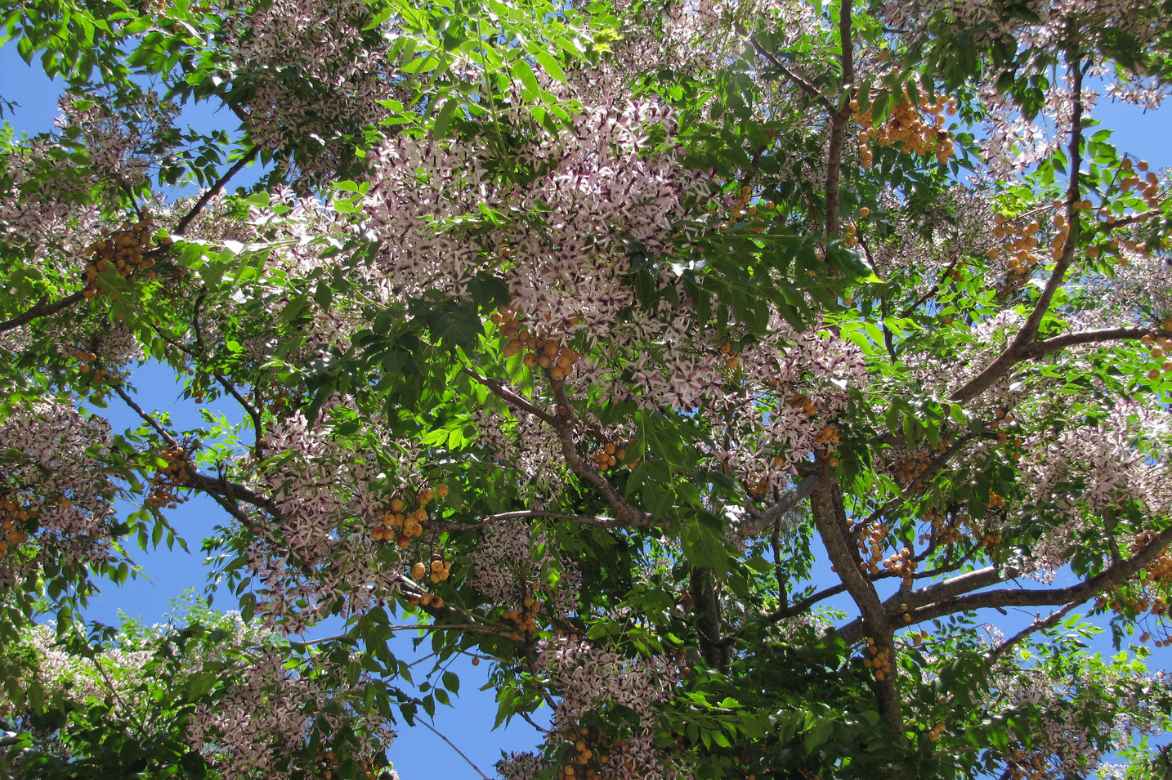
Melia azedarach (© Luc Coekaerts)
Parasitic and diseases
The Melia, although generally robust and resistant to many parasitic pests and diseases, is not entirely immune to certain issues. Among the most common are attacks by insects such as aphids, which can cluster on young shoots and leaves, sucking the sap and weakening the tree. These aphid infestations often leave behind a sticky residue, honeydew, which can encourage the development of sooty mould, a blackish fungus that forms on the leaves.
Additionally, the Neem tree can sometimes be affected by fungal diseases, particularly when conditions are humid or if air circulation around the tree is poor. These diseases often manifest as spots or discolouration on the leaves. However, there’s no need to worry—these issues are relatively rare and seldom require intervention.
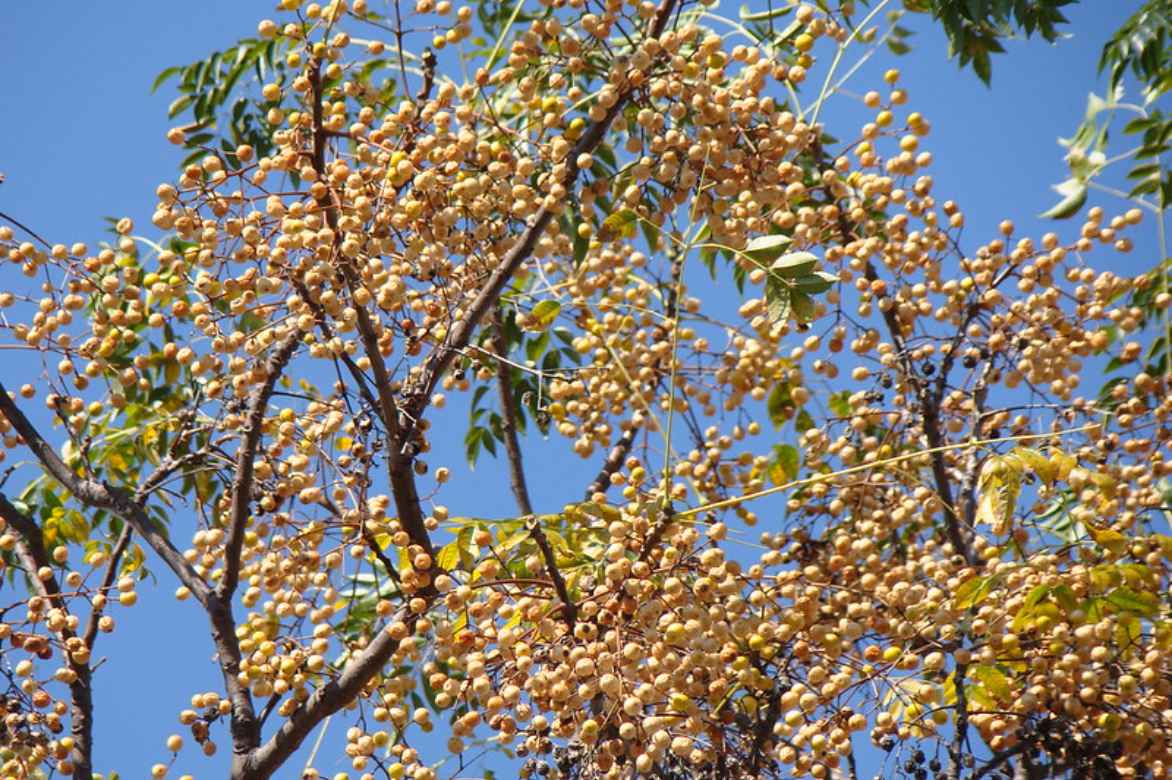
Autumn fruiting (© Mauro Halpern)
Multiplication of Melia
Sowing seeds is the most natural and common method. Seeds, once extracted from their fruits, should be planted shortly after the harvest for better germination. The germination process can be facilitated by soaking the seeds in water overnight before sowing. Planting is typically done in spring in a well-drained substrate and under moderate temperature conditions.
In addition to sowing, the Neem tree can also be propagated by cuttings, although this method is less common. Propagation by cuttings involves taking young shoots or stems from the current year, preferably in early summer, and planting them in a mixture of compost and sand to encourage rooting. Rooting is promoted by a warm and humid environment, and the cuttings should be carefully monitored to ensure their success.
How to pair a Melia azedarach?
Consider creating a harmonious understory beneath the canopy of the Margousier, where hostas, with their lush and varied leaves, can thrive in the dappled shade. Ferns, such as the ostrich fern or the male fern, offer delicate green foliage that contrasts beautifully with the more robust structure of the Margousier.
To complement the Margousier’s spring flowering, consider bushes like azaleas or rhododendrons, which bring a burst of colour at the same time. Their vibrant flowers and evergreen leaves add depth and texture beneath the Margousier.
Near the base of the tree, ground covers such as Lesser periwinkle or common ivy can spread, creating a lush green carpet that balances the height of the Margousier. These plants are hardy and low-maintenance, pairing well with the easy-going nature of the Margousier.
For continuous seasonal interest, incorporate perennials that bloom in summer or autumn, such as daylilies or asters, to maintain the visual appeal of the garden even after the Margousier’s flowering period has ended.
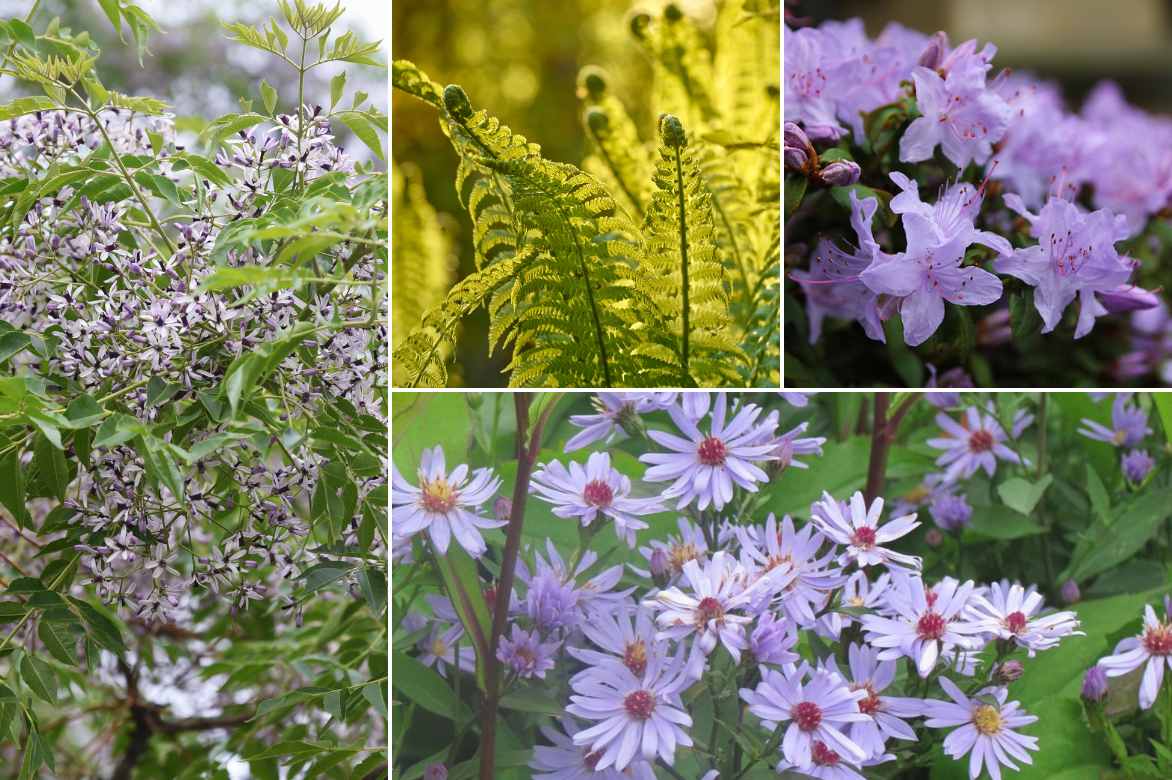
Melia azedarach, Ostrich Fern, Rhododendron ‘Blue Tit’ flowering at the same time, and Aster cordifolius ‘Little Carlow’ which will bloom in late summer.
Anecdotes
- Bead Tree: In Turkey and other regions, the Neem Tree is nicknamed the “Bead Tree” because its hard, smooth seeds have traditionally been used to make rosaries.
- Music and Medicine: In some cultures, the wood of the Neem Tree is used to make musical instruments, while in others, it is valued for its medicinal properties. Its leaves, fruits, and bark have been used in traditional medicine (in China and Australia) to treat various ailments.
- Symbol of Resilience: The Neem Tree is often planted in urban areas for its ability to withstand pollution. Its endurance in harsh conditions makes it a symbol of resilience and a popular choice for urban landscaping.
- Natural Insecticide: The fruits and leaves of the Neem Tree are known for their natural insecticidal properties. They have been used in many cultures to protect crops and homes from harmful insects, highlighting the importance of this tree in traditional agricultural practices.
Frequently asked questions
-
Is the Neem tree suitable for all types of gardens, and can it be grown in a pot?
Its pruning, which can reach 10 to 15 metres in height, makes it an ideal choice for large gardens or public spaces where it can thrive without constraints. However, its pruning and extensive root system make it less suitable for small gardens or confined spaces.
As for container cultivation, although technically possible, it presents challenges. The Neem tree needs space for its roots to develop, and a pot would limit its growth. Moreover, a potted tree requires more regular maintenance, particularly in terms of watering and nutrition. If you wish to grow a Neem tree in a pot, it is advisable to choose a young specimen and provide a large container, while being aware that its growth will be limited and it will likely never reach its maximum size.
-
Are there any special precautions to take due to the toxicity of the Neem tree's fruits?
If you have children or pets, it is crucial to supervise them around the tree to prevent them from consuming the fruits or seeds. Explain to children that the fruits are not edible and can be dangerous.
Collect the fallen fruits from the soil regularly to reduce the risk of accidental ingestion by children or pets. And of course, when planting a Neem tree, choose a location away from children's play areas and places frequented by pets.
-
What is the lifespan of a Neem tree, and how does it evolve through the seasons?
The lifespan of a Neem tree can be quite long, often several decades, and in some cases, it can live up to a century or more, especially when planted in ideal conditions and given proper care. The evolution of this tree through the seasons is also remarkable.
In spring, the Neem tree enters a period of active growth. This is when its distinctive flowers, typically lilac or purple in colour, appear, forming fragrant clusters that attract various pollinators.
In summer, after flowering, the fruits begin to form. These are small drupes that gradually ripen, turning from green to yellow or brown. These drupes add visual interest to the tree and attract wildlife, particularly birds.
In autumn, the leaves of the Neem tree begin to change colour, offering a display of yellow and golden hues before falling. The tree thus prepares for winter by entering a period of dormancy.
In winter, the Neem tree loses most, if not all, of its leaves, revealing its branch architecture. Although it appears inactive during this period, the tree focuses its energy on root development and prepares for the next spring's growth cycle.
Over the years, the Neem tree continues to grow in size and maturity, offering a majestic habit and continuous seasonal interest in the landscape. Its longevity and beauty throughout the seasons make it a popular choice for parks, public gardens, and large residential spaces.
-
Can the wood or other parts of the Neem tree be used for domestic or artisanal purposes?
The wood of Melia azedarach is prized for its strength and durability. It is often used in the manufacture of furniture, timber framing, and art objects. Its fine texture and excellent finishing qualities make the wood of the Chinaberry tree suitable for detailed carpentry work. In some cultures, the wood of the Chinaberry tree is used to make musical instruments due to its good acoustic resonance. The seeds of the Chinaberry tree, which are particularly hard and smooth, are used to create beads for rosaries, jewellery, and other artisanal items. They are valued for their natural aesthetic and durability.
Extracts from the leaves and fruits of the Chinaberry tree have insecticidal properties and can be used to prepare natural insect repellents.
- Subscribe!
- Contents
































Comments